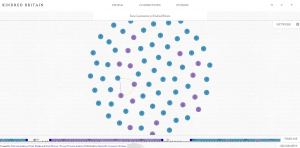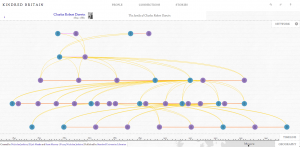The Kindred Britain website by Stanford University helps to show the known family trees and connections of and between historical figures. The website also provides information about the degrees of separation between different figures. The use of digital humanities brings the information to life and engages the user. Kindred Britain succeeds in making the website interactive and easy to use.
The primary digital humanities approach used in the creation of this website is visualization. The information and family connections are graphically displayed in a series of bubbles, as shown below. The simple background andcolor scheme balances well with the large amount of information.

Other key focuses of the website include networking and archives. Many of the people and information provided are from centuries ago; therefore this is an archival source. The digital humanities component of this site modernizes the archival material. Visualizing the data into networks that the user can click for more information was quite appropriate for the subject matter.
Here is an example of a typical family tree. This one shows Charles Darwin’s connections. The creators of the site were able to provide quite a bit of information about his lineage. An interesting fact Kindred Britain provides is that he is only fi ve degrees of separation from Virginia Woolf. This is just one example of the many networks and archival information that the site provides.
ve degrees of separation from Virginia Woolf. This is just one example of the many networks and archival information that the site provides.
Kindred Britain combines valuable historical data with style to further emphasize the information being presented.
Leave a Reply